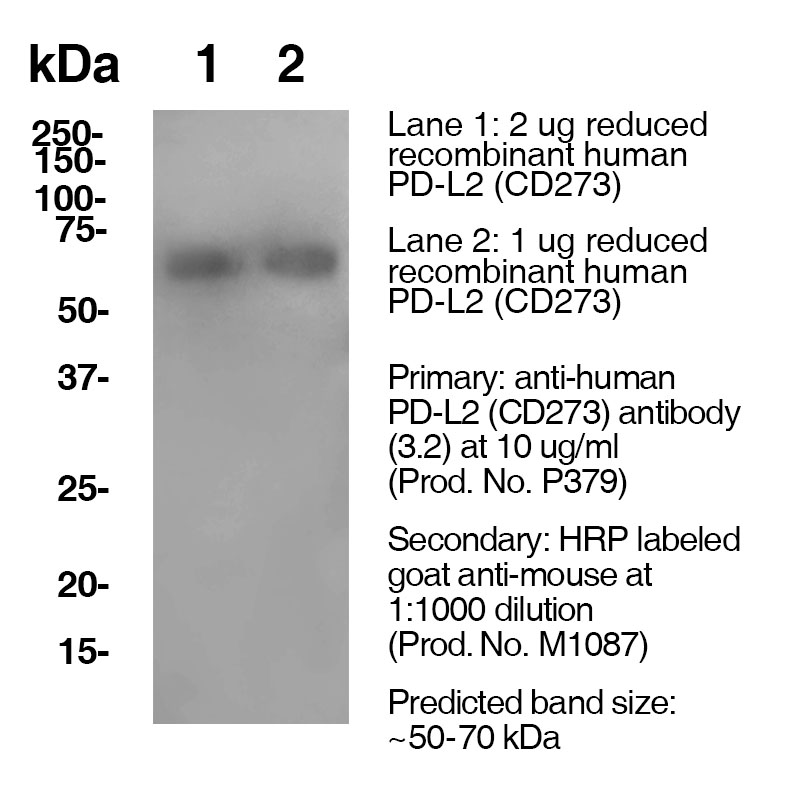Anti-Mouse CD273 (PD-L2) (Clone 3.2.B8) – Purified in vivo PLATINUM™ Functional Grade
Anti-Mouse CD273 (PD-L2) (Clone 3.2.B8) – Purified in vivo PLATINUM™ Functional Grade
Product No.: P679
- -
- -
Clone 3.2.B8 Target PD-L2 Formats AvailableView All Product Type Monoclonal Antibody Alternate Names B7-DC, CD273, PDL2, B7DC, Clone 3.2 Isotype Mouse IgG1 Applications B , FC , in vivo , WB |
Data
- -
- -
Antibody DetailsProduct DetailsReactive Species Human ⋅ Mouse Host Species Mouse Recommended Isotype Controls Recommended Isotype Controls Recommended Dilution Buffer Immunogen Made in PD-L2 knockout mouse fusion partner X63-Ag8.653 myeloma cells Product Concentration ≥ 5.0 mg/ml Endotoxin Level <0.5 EU/mg as determined by the LAL method Purity ≥98% monomer by analytical SEC ⋅ >95% by SDS Page Formulation This monoclonal antibody is aseptically packaged and formulated in 0.01 M phosphate buffered saline (150 mM NaCl) PBS pH 7.2 - 7.4 with no carrier protein, potassium, calcium or preservatives added. Due to inherent biochemical properties of antibodies, certain products may be prone to precipitation over time. Precipitation may be removed by aseptic centrifugation and/or filtration. Product Preparation Functional grade preclinical antibodies are manufactured in an animal free facility using in vitro cell culture techniques and are purified by a multi-step process including the use of protein A or G to assure extremely low levels of endotoxins, leachable protein A or aggregates. Pathogen Testing To protect mouse colonies from infection by pathogens and to assure that experimental preclinical data is not affected by such pathogens, all of Leinco’s Purified Functional PLATINUM™ antibodies are tested and guaranteed to be negative for all pathogens in the IDEXX IMPACT I Mouse Profile. Storage and Handling Functional grade preclinical antibodies may be stored sterile as received at 2-8°C for up to one month. For longer term storage, aseptically aliquot in working volumes without diluting and store at ≤ -70°C. Avoid Repeated Freeze Thaw Cycles. Country of Origin USA Shipping Next Day 2-8°C RRIDAB_2831658 Applications and Recommended Usage? Quality Tested by Leinco Western Blot: For Western blot analysis at a concentration of 1.0-2.0 µg/ml when used in conjunction with compatible secondary reagents Each investigator should determine their own optimal working dilution for specific applications. See directions on lot specific datasheets, as information may periodically change. DescriptionDescriptionSpecificity Clone 3.2.B8 recognizes an epitope on mouse/human PD-L2 and has been shown to bind to both mouse and human PD-L2 equally well Background PD-1 is a 50-55 kD member of the B7 Ig superfamily. PD-1 is also a member of the extended CD28/CTLA-4 family of T cell regulators and is suspected to play a role in lymphocyte clonal selection and peripheral tolerance. The ligands of PD-1 are PD-L1 and PD-L2, and are also members of the B7 Ig superfamily. PD-1 and its ligands negatively regulate immune responses. PD-L1, or B7-Homolog 1, is a 40 kD type I transmembrane protein that has been reported to costimulate T cell growth and cytokine production. The interaction of PD-1 with its ligand PD-L1 is critical in the inhibition of T cell responses that include T cell proliferation and cytokine production. PD-L1 has increased expression in several cancers. Inhibition of the interaction between PD-1 and PD-L1 can serve as an immune checkpoint blockade by improving T-cell responses In vitro and mediating preclinical antitumor activity. Within the field of checkpoint inhibition, combination therapy using anti-PD1 in conjunction with anti-CTLA4 has significant therapeutic potential for tumor treatments. PD-L2 is a 25 kD type I transmembrane ligand of PD-1. Via PD-1, PD-L2 can serve as a co-inhibitor of T cell functions. Regulation of T cell responses, including enhanced T cell proliferation and cytokine production, can result from mAbs that block the PD-L2 and PD-1 interaction. Antigen Distribution PD-L2 is expressed on dendritic cells, liver, few transformed cell lines, and a subset of macrophages. Ligand/Receptor PD-1 Function Binds to PD-1 and alternative receptor NCBI Gene Bank ID UniProt.org Research Area Costimulatory Molecules . Immunology References & Citations1.) Akbari O, Stock P, Singh AK, Lombardi V, Lee WL, Freeman GJ, Sharpe AH, Umetsu
DT, Dekruyff RH. PD-L1 and PD-L2 modulate airway inflammation and iNKT-cell-
dependent airway hyperreactivity in opposing directions. Mucosal Immunol. 2010; 3:81-
91. PMCID: PMC2845714 2.) . Xiao Y, Yu S, Zhu B, Bedoret D, Bu X, Francisco LM, Hua P, Duke-Cohan JS, Umetsu DT, Sharpe AH, DeKruyff RH*, Freeman GJ* (* indicates co-senior authors). RGMb is a novel binding partner for PD-L2 and its engagement with PD-L2 promotes respiratory tolerance. J Exp Med. 2014; 211:943-59. PMCID: PMC4010901. Technical ProtocolsCertificate of Analysis |
Related Products
- -
- -
Prod No. | Description |
|---|---|
S211 | |
R1364 | |
I-536 | |
M1188 | |
C247 | |
F1175 | |
S571 |



